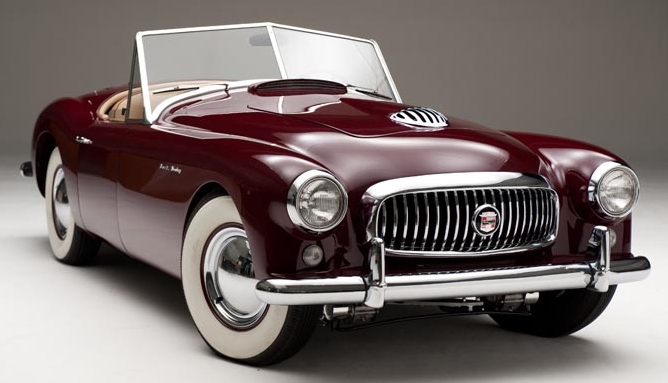Unusual Automotive Treasures
|
Sold for $500,000 in January 2013 Engine:Nash Ambassador I6: 1951: 234.8 cu in (3.8 L) 125 hp (93 kW; 127 PS) Transmission: 3-speed manual with overdrive |
|
1950 Nash-Healey Roadster |
|
|
Like many of life’s treasures, the
Nash-Healey’s birth was an unlikely confluence of events. Its beginnings
sprang from a chance meeting in 1949 aboard the Queen Elizabeth, between
Donald Healey and George Mason, president of Nash-Kelvinator Co. Mason
wanted a sports car to improve the image of his automobile company and
Healey was on his way to back to England after failing to acquire
Cadillac engines from GM for his new sports car. They agreed that motor
racing was a necessity in the development and promotion of a sports car.
Mason thought his Ambassador engine would be perfect. The rest, as they
say, is history: America’s first true sports car, designed from the
beginning to go toe to toe with the world’s finest. Conceived with the
engineering genius of England’s master car designer and nurtured by the
financial backing of a great American industrial corporation, the
results were predictable – one of the great cars of the age. As soon as
first prototypes were ready, they began to appear on the race tracks of
the world among some very famous company. The Nash-Healey is a two-seat sports car that was produced for the American market between 1951 and 1954. Marketed by Nash-Kelvinator Corporation with the Nash Ambassador drivetrain and a European chassis and body, it served as a halo (or image) vehicle, or flagship car, for the automaker to promote the sales of the other Nash models. It was "America's first post-war sports car", and the first introduced in the U.S. by a major automaker since the Great Depression. The Nash-Healey was the product of the partnership between Nash-Kelvinator Corporation and British automaker Donald Healey. Later on, the car was restyled by Pinin Farina and subassembly begun in Italy. Healey designed the aluminum body, but it was outsourced. Panelcraft Sheet Metal of Birmingham fabricated the body. It incorporated a Nash grille, bumpers, and other trim. Healey was responsible for the car's final assembly. The car had drum brakes all round. Wheels were steel, dressed up with full-diameter chrome hubcaps and 4-ply 6.40 x 15-inch whitewall tires. The interior featured luxurious leather upholstery, foam rubber cushions, adjustable steering wheel, and a cigarette lighter. Completed vehicles were shipped to the United States for sale through the Nash dealership network. A prototype was exhibited at the Paris Motor Show in September 1950. The production model debuted at the February 1951 Chicago Auto Show and Donald Healey gave the first example to Petula Clark. The only colors available were "Champagne Ivory" and "Sunset Maroon", and the suggested retail price (MSRP) of US $3,767 F.O.B. New York City proved uncompetitive. The Nash-Healy was a top three finisher after the Mercedes-Benz team one and two at Le Mans in 1952. This is truly a unique automotive treasure. |

